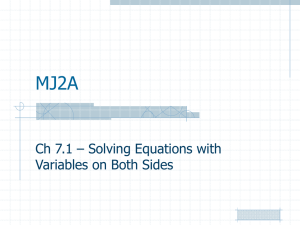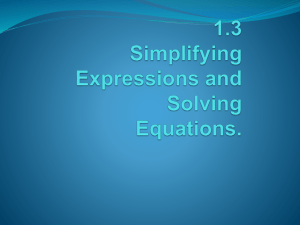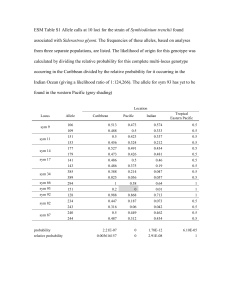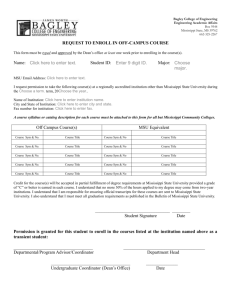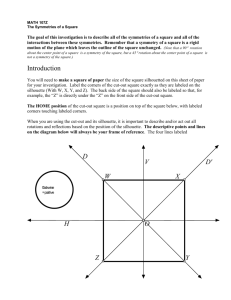The quark-antiquark potential in N=4 Super Yang Mills
advertisement
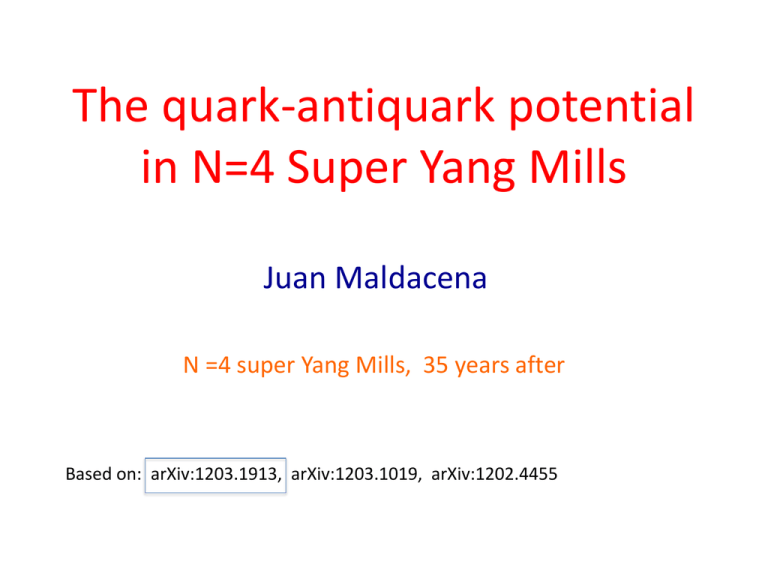
The quark-antiquark potential in N=4 Super Yang Mills Juan Maldacena N =4 super Yang Mills, 35 years after Based on: arXiv:1203.1913, arXiv:1203.1019, arXiv:1202.4455 Diego Correa (Also similar paper by Drukker) Amit Sever Johannes Henn Polyakov Drukker Gross Ooguri JM Rey Yee • When θ=φ the configuration is BPS and the potential vanishes. Zarembo Witten-Kapustin (Langlands) • When δ=π-φ 0 , we get the quark-antiquark potential in flat space. • When i φ= ϕ Infinity, Computed by Beisert, Eden Staudacher Motivations • Flux lines going between quark and anti-quark become a string. Understand this string and its excitations. • It is a function of an angle + the coupling • Similar to amplitudes • In fact, it controls the IR divergencies of amplitudes for massive particles. Final Answer Write integral equations for a set of functions YA(u): Compute the potential as: Method How did Coulomb do it ? We will follow a less indirect route, but still indirect.. Integrability in N=4 SYM • N=4 is integrable in the planar limit. Minahan Zarembo Bena Polchinski Roiban Beisert, etc… • Large number of symmetries How do we use them ? • There is a well developed method that puts these symmetries to work and has lead to exact results. • It essentially amounts to choosing light-cone gauge for the string in AdS, and then solving the worldsheet theory by the bootstrap method. • First we consider a particular SO(2) in SO(6) and consider states carrying charge L under SO(2) . Operator Z = φ5 + i φ6 • States with the lowest dimension carrying this charge Lightcone ground state for the string Infinite chain or string • L= ∞ • Ground state: chain of ZZ….ZZZ..ZZZ p • Impurities that propagate on the state ZZ…ZWZ…ZZZ • Symmetries Beisert • Elementary worldsheet excitations 4 x 4 under this symmetry. • Fix dispersion relation • Fix the 2 2 S matrix. Matrix structure by symmetries + overall phase by crossing. Beisert Janik Hernandez Lopez Eden Staudacher • Solves the problem completely for an infinite (or very long) string. Beisert Staudacher equations Short strings • Consider a closed string propagating over a long time T L TBA trick: Zamolodchikov T • View it as a very long string of length T, propagating over eucildean time L = Thermodynamic configuration. • In our case the physical theory and the mirror theory are different. Yang-Yang • Solve it by the Thermodynamic Bethe Ansatz = sum over all the solutions of the mirror Bethe equations over a long circle T weighed with the Boltzman factor. Arutyunov Frolov Gromov Kazakov Vieira Bombardelli, Fioravanti, Tateo YA= (densities of particles)/(densities of holes) as a function of momentum A runs over all particles and bound states of particles in the fully diagonalized nested bethe ansatz Back to our case • Where is the large L ? • Nowhere ? Just introduce it and then remove it ! ZL x • Operators on a Wilson line: For large L = same chain but with two boundaries. Drukker Kawamoto • Need to find the boundary reflection matrix. • Constrained by the symmetries preserved by the boundary = Wilson line • Bulk magnon = pair of magnons of p Half line with SU(2|2)2 in bulk -p p full line, single SU(2|2)D Reflection matrix = bulk matrix for one SU(2|2) factor up to an overall phase Determined via a crossing equation. We used the method given by Volin, Vieira This is the hardest step, and the one that is not controlled by a symmetry. In involves a certain degree of guesswork. We checked it in various limits. • We solve the problem for large L: add the two boundaries L Z x ZL x Rotate one boundary Introduce extra phases in the reflection matrix. Going to small L Boundary TBA trick: LeClair, Mussardo, Saleur, Skorik Closed string between two boundary states. Bulk magnons emanate from the boundary with amplitude given by the (analytic continued) reflection matrix. Using the bulk crossing equation we can untangle the lines and cancel the bulk S matrix factors. We are left with a pair of lines on the cylinder. This looks like a thermodynamic computation restricted to pairs with p and –p . Then we essentially get the same as in the bulk for a thermodynamic computation with And a constraint on the particle densities: Figure 8: (a) Set of Ya,s funct ions for t he closed string problem. Here we have t he same set but t he addit ional condit ion (61) implies t hat we can restrict t o t he set in (b). Final Equations Let us summarize the final equat ions Y1,1 1 + Y 1,m 1 + Y m ,1 (01) = K m − 1 ∗ log + R 1 a ∗ log(1 + Ya,0) Y 1,1 1 + Y 1,m 1 + Ym ,1 Y 2,2 1 + Y 1,m 1 + Y m ,1 (01) log = K m − 1 ∗ log + B1 a ∗ log(1 + Ya,0) Y 2,2 1 + Y 1,m 1 + Ym ,1 log Y 1,s 1 + Y 1,t 1 + Y1,1 = − K s− 1,t − 1 ∗ log − K s− 1∗ˆ log Y 1,s 1 + Y 1,t 1 + Y 2,2 Ya,1 1 + Yb,1 1 + Y1,1 log = − K a− 1,b− 1 ∗ log − K a− 1∗ˆ log Y a,1 1 + Y b,1 1 + Y 2,2 log + R ab + Ba− 2,b ∗ log(1 + Yb,0) (01) log Ya,0 = Y a,0 (11) (11) 2Sa b − R a b + Ba b (1 0) + 2R a 1 sym ∗ˆ log (01) 0) (1 0) ∗ log(1 + Yb,0) + 2 R (1 ∗ log a b + Ba,b− 2 sym 1 + Y1,1 1 + Y 2,2 (1 0) − 2Ba 1 sym ∗ˆ log 1 + Y 1,1 1 + Y 2,2 (62) (63) (64) (65) 1 + Yb,1 1 + Y b,1 (66) where we used t he convent ions of [58, 59] for the kernels and integrat ion cont ours5 . We have (here) (t here) also defined t he barred Y ’s as Y a,s = 1/ Ya,s , (see appendix E.3 for a summary). Here, the momentum carrying Ya,0 functions are defined as symmetric functions Ya,0(− u) = Ya,0(u) and sym ∗ f (v) = [∗f (v) + ∗f (− v)]/ 2 is a symmetric convolut ion6. There are implicit sums over 5 T he convolut ions of t erms depending on Y or Y are over a finit e range |u| ≤ 2g. We use ˆ∗ as a • Now we can set L =0 and get Γcusp • We did not solve the equations in general. • We expanded for weak coupling. The leading order in weak coupling is easy and it reproduces the known result. A simplified limit • At φ=θ=0 , we have a BPS situation. Near this point we have • Simplified equations lead to a set of integral equations for B(λ). Still non-linear but less complicated. We know the answer by localization • It is just given by a Bessel function: Correa, Henn, JM Fiol, Garolera, Lewkowycz Pestun, Drukker, Giombi, Ricci, Trancanelli • The expansion agrees with the result in the integral equation. • Also gives the power emitted by a moving quark • The integral equations, at least for this case, can be simplified! • Hopefully the same is the case for the general case. • The TBA equation are complicated, but they contain the information also about all excited states. Discussion • Integral equations for excited states should be very similar. Gromov, Kazakov, Vieira • These equations can be studied numerically • The next goal Simplify! Finite number of function: Gromov, Kazakov, Leurent, Volin • The connection between integrability and localization is useful to fix one possible undetermined function of the coupling. It is thought to be trivial in N=4 SYM. But it is known to be non-trivial for ABJM. Happy birthday N=4 SYM Do we know all N=4 theories? • Classify all theories with N=4 susy in four dimensions • Without assuming that they have a weak coupling limit. • Derive the existence of the weak coupling limit…






